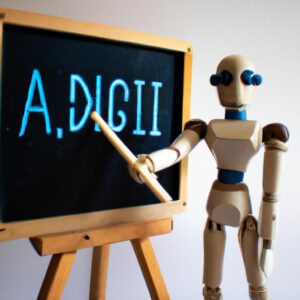Introduction to Artificial Intelligence in Education
Artificial Intelligence (AI) is a rapidly developing field of technology that has captured the imagination of many across the world. In recent years, AI has become increasingly prevalent in our everyday lives, from the smartphones and computers we use daily to the automated systems businesses rely upon each day. The potential applications for AI are vast and its impacts are being felt in almost every sector.
AI has proven to be especially powerful in the educational sector, as it can improve existing teaching methods and help schools run more efficiently. From automating administrative tasks to personalizing content for individual learners, AI can revolutionize the educational landscape if implemented strategically.
In this guide, we will look at how AI is transforming education. We will explore the benefits AI offers, the challenges posed by this technology, examples of AI technologies, current trends, implementation strategies, and more. By the end of this guide, readers should have a solid foundation on which they can begin to explore the world of AI in education.
Benefits of AI in Education
Artificial Intelligence (AI) brings with it the potential to revolutionize education. AI has the ability to provide personalized instruction, automate routine tasks, and enable faster and more comprehensive analyses of student data. These advantages can help improve both the efficiency and effectiveness of education.
AI-based systems and technologies have the potential to increase efficiency in the educational sector in a number of ways. AI-powered automation can take on many of the administrative tasks that educators must complete, such as grading and tracking attendance. This can free up time for teachers to focus on developing relationships with their students and providing quality instruction. AI can also streamline the process of analyzing large quantities of student data. It can quickly identify patterns and trends that may otherwise be overlooked, allowing for more effective decision-making.
Another benefit of AI in Education is that it can provide a more personalized learning experience for students. AI-enabled technologies can generate customized lessons and materials tailored to each individual student’s needs and interests. It can also monitor student progress and adjust instruction accordingly. This can help students stay engaged and motivated, which can lead to better performance and improved educational outcomes.
AI-enabled systems can also track student behavior and alert teachers to any potential issues. By providing teachers with real-time information about their students, they can better recognize signs of distress and intervene accordingly. AI can also help create a safe and welcoming environment for all students by monitoring for bias in online discourse among students and moderating discussions as necessary.
Above all, AI can be used to empower students and to level the playing field for those who may not have access to the same level of resources or opportunities. AI-driven tools and systems can help students with disabilities by providing them with specialized assistance. Additionally, AI-assisted learning systems can help students who are unable to attend traditional schools due to economic, family, or physical constraints.
Challenges Posed By AI in Education
AI has been hailed as a potential ‘game-changer’ in many areas, including the educational sector. Despite its numerous potential benefits, however, there are some challenges that must be considered in order for successful implementation. Perhaps the most notable of these challenges is ethical considerations.
AI systems are designed to make decisions based on algorithms developed by humans. As such, it is important to consider how ethical values are represented within the algorithms. For example, AI systems may be used to make decisions regarding student’s admissions or grading, both of which can be affected by underlying biases and preferences. It is also important to consider how AI systems are used to evaluate and rank teachers.
In addition to ethical considerations, other potential challenges posed by AI in the educational sector include the need for reliable data-sets; the maintenance, upkeep and security of AI technology; and the fact that AI can be a complex and expensive technology to implement.
It is also important to note that AI systems can still be easily fooled and manipulated by malicious actors. Therefore, adequate security measures must be taken to ensure the safety and integrity of any AI system in use. In addition, AI may be seen as a threat to jobs, although this is typically unlikely as AI technology can supplement existing roles rather than replacing them.
Examples of AI in Education
Artificial intelligence (AI) has become increasingly popular in the educational space in recent years, impacting multiple aspects of teaching and learning. AI-related technologies can help streamline the process of education, while enhancing the overall quality of instruction. Here are just a few examples of how AI is being used in education:
- AI-Powered Tutoring Systems: AI-powered tutoring systems are designed to provide personalized instruction to students. These systems use machine learning to identify and recognize individual students’ strengths and weaknesses, and then customize teaching content to create a unique learning experience. AI tutoring can improve student engagement and help them master complex concepts more quickly.
- AI-Assisted Grading: AI-assisted grading technology uses machine learning algorithms to automate the grading process. AI can quickly grade essays and multiple-choice tests accurately and reliably, freeing up educational professionals so that they can focus on other tasks.
- AI-Based Learning Management Systems: AI-based Learning Management Systems (LMS) use data to create adaptive course curricula for students, allowing teachers to tailor learning experiences based on each student’s abilities, needs, and interests.
AI technology can be incredibly useful in the educational sector, as it has the potential to revolutionize the way in which students learn. By implementing AI-driven tools, schools can ensure that each student is receiving personalized instruction that caters to their individual needs.
Current Trends in AI in Education
AI is increasingly being used in the educational sector, across a variety of industries such as schools, universities, and even corporate training. Many organizations are embracing the potential of AI to revolutionize the educational system, creating personalized learning experiences for students and leveraging data to create more efficient and effective practices. Here, we explore the main trends that are shaping the future of AI in Education.
Virtual assistants
Virtual assistants are becoming an increasingly popular tool in the educational space. They provide support for students and teachers, offering personalized responses to questions, providing interactive tutorials, and tracking student progress. Virtual assistants can also be used to automate administrative tasks, allowing teachers to spend more time teaching and less time on administrative work.
Data-driven decision-making
AI is enabling educational institutions to leverage data to make more informed decisions. Schools are using AI-powered analytics tools to gain real-time insights into student performance, providing a detailed view of student behaviour and enabling educators to tailor their approach to each individual’s needs. Similarly, AI can be used to analyze the effectiveness of particular strategies or curriculum changes, allowing administrators to optimize their processes.
Personalization
AI-powered personalization technologies are transforming the way students learn. Through AI, teachers can create customized learning plans and tailor the content to suit each student’s individual needs, interests, and abilities. AI can also be used to provide feedback and guidance to students, helping them develop the skills and knowledge they need to succeed.
Automation
AI is also revolutionizing the way tests are administered. Automation technologies allow teachers to design tests that can be securely taken online. This eliminates the need for manual administration and grading, freeing up teachers’ time for more creative and engaging activities with their students.
Augmented Reality (AR)
Finally, augmented reality (AR) is becoming an increasingly popular technology in the educational field. AR allows students to engage with physical objects and environments virtually, allowing for a more immersive learning experience. It can also be used to add context to lessons, for example, by allowing students to explore a foreign city from the comfort of their classroom.
These are just some of the trends in AI in Education that are helping transform the way we think about learning. As technology advances, we can expect to see further developments that will continue to revolutionize the educational sector.
Implementation: What Schools Can Do
One of the primary concerns when implementing AI in education is understanding the practicalities of doing so. Fortunately, there are some straightforward steps that schools can take to get started.
- Research and identify potential AI solutions: Schools should research the various AI solutions available and assess which would be most beneficial for their students.
- Develop a plan for implementation: Most AI solutions require a certain degree of customization, so schools must create a plan considering their resources, timeline, budget, and other factors.
- Create a supportive environment: To ensure successful implementation, schools must create an environment conducive to change and promotion of new technologies.
- Train staff members: It is important to train teachers and administrators on how to use AI technologies and manage data thereby maximizing its value.
- Develop data security protocols: Schools must create data security protocols to protect any sensitive student information stored within AI systems.
By taking these steps, schools can reap the many benefits of using AI in their educational processes. Of course, it is important to note that each school’s needs and resources are different, so it is best to seek out expert advice and assistance when developing a plan for AI implementation.
Conclusion
Artificial Intelligence (AI) is a rapidly growing field with endless potential to transform the way we educate our children. AI can offer increased efficiency, personalization, and the ability to provide unique educational opportunities. Despite the promising benefits, it is important to consider the potential challenges posed by AI, such as ethical considerations. Schools should be prepared to embrace AI with an open mind and use it to best benefit their environment. With further developments in the AI space, the future of AI in Education looks bright.
This guide reviewed the concept of AI and its implications for Education, some of the key advantages and challenges brought by AI, current trends and potential implementations in Schools, and provided additional resources, reviews, and contact information.
By remaining informed on the advancements that AI brings to Education, Schools can work towards the goal of providing the best quality of education to their students.
Additional Resources
For those looking to learn more about the future of artificial intelligence (AI) and its implications for the educational sector, there are numerous resources available. This section will recommend some books, articles, websites and other topics related to AI in education.
Books such as ‘The Age of
Review: The Future of AI in Education
As we have discussed, Artificial Intelligence (AI) has the potential to revolutionize education as we know it. We have already seen several examples of how AI can be used to improve efficiency and personalization in the educational sector. However, this technology also presents some challenges that must be addressed before implementation.
The future of AI in education is bright, with many possibilities still to be explored. AI can be used to automate time-consuming administrative tasks, allowing teachers and school staff more time to focus on providing quality instruction. Additionally, AI can enable more personalized learning experiences tailored to each student’s individual needs. With AI, schools can further develop their data-driven approaches to improve not only how they teach, but also how they assess their students.
Furthermore, AI can also offer new ways to enhance teacher training and development. By relying on AI to analyze student performance data, teachers can receive better feedback on their instructional methods, as well as identify areas where they may need to focus more attention. AI can also help to uncover trends in student behaviors, and provide educators with deeper insights so they can tailor their lessons in accordance with the results.
As AI continues to develop and evolve, there are sure to be more applications and uses for this technology. It is important to understand the risks associated with AI, and to work towards mitigating them. By being proactive in developing responsible approaches to AI, schools will be able to make the most of its potential benefits while minimizing any negative impacts.
Glossary
When learning or discussing artificial intelligence (AI) in education, it’s important to understand the key terms and acronyms associated with the subject. This section provides concise definitions of key terms related to AI in education:
- Artificial Intelligence (AI): A branch of computer science which focuses on creating machines that can think and act like humans.
- Machine Learning (ML): A subset of artificial intelligence which enables machines to learn from data and automatically make decisions based on that data.
- Natural Language Processing (NLP): A form of artificial intelligence which enables machines to analyze and interpret natural human language.
- Computer Vision (CV): A form of artificial intelligence which enables machines to recognize and interpret visual data.
- Deep Learning (DL): A subset of machine learning which uses layers of neural networks to identify patterns, detect anomalies, and classify data.
Bibliography
At the end of this guide, we have included a list of references to sources used throughout. These references include books, articles, websites, and other related topics.
Some of the most essential sources are as follows:
- Carbonell, J. G., and S. B. Mills. “The Challenges of Developing Educational Expert Systems.” AI Magazine, vol. 9, no. 2, 1988, pp. 56–63.
- Khademian, M. F., et al. “Exploring the Effectiveness of Artificial Intelligence-Supported Education.” International Journal of Information and Instructional Science, vol. 1, no. 5, 2018, pp. 25–32.
- Kumar, Varun. “AI in Education: Opportunities and Challenges.” IEEE Access, vol. 7, 2019, pp. 16382–16398.
- Pearson, P. “Artificial Intelligence in Education.” ST Engineering-NTU Corporate Lab – Research Briefing, June 2018. https://www.ntu.edu.sg/cri/sfe/Documents/Research%20Briefings/SFE_RB_2018_001_Artificial_Intelligence_in_Education.pdf
- Vasilakis, C. “Applying Artificial Intelligence in Education: Current State and Future Prospects.” Educational Technology & Society, vol. 22, no. 2, 2019, pp. 36–52.
We hope this bibliography will be useful in providing an understanding into the concept of AI in Education.
Contact Information
If you have any questions about AI in Education or would like to discuss the topic further, please do not hesitate to contact us. We’d be more than happy to assist you with any enquiries you may have. Here are some useful contact methods:
- Email: [email protected]
- Phone: +1 111 222 3333
- Website: www.aiineducation.com
We look forward to hearing from you!
comments: 0











